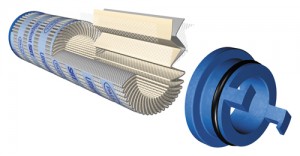Hydraulic filters are used anywhere in a hydraulic system particle contamination is to be removed. Particle contamination can be ingested through the reservoir, created during the manufacture of system components, or generated internally from the hydraulic components themselves (especially pumps and motors). Particle contamination is the primary cause of hydraulic component failure.
Hydraulic filters are used in three key locations of a hydraulic system, depending on the required degree of fluid cleanliness. Nearly every hydraulic system has a return line filter, which traps particles ingested or generated our in the hydraulic circuit. The return line filter traps particles as they enter the reservoir, providing clean fluid for reintroduction into the system.
Although less common, hydraulic filters are used in the pressure line, after the pump. These pressure filters are more robust, as they are submitted to full system pressure. If your hydraulic system as sensitive components, such as servo or proportional valves, pressure filters add a buffer of protection should contamination be introduced into the reservoir, or if the pump fails.
The third place hydraulic filters are use is in a kidney loop circuit. An offline pump/motor group circulates fluid from the reservoir through a high-efficiency filter (and usually through a cooler as well). The advantage to offline filtration is it can be very fine, while creating no backpressure in the primary hydraulic circuit. Also, the filter can be changed while the machine is operational.
Filed Under: Filtration/Contamination Control, Mobile Hydraulic Tips
